
Satellite streaks block out the Arctic sky | Space photo of the day for June 20, 2025
How did your country report this? Share your view in the comments.
Diverging Reports Breakdown
Satellite streaks block out the Arctic sky | Space photo of the day for June 20, 2025
Researchers from Western University in Canada used 14 low-cost cameras to track satellites passing overhead. The system was inspired by meteor tracking, with cameras pointed in various angles to catch the entire night sky. To date, the system has found over 17,000 unique satellites and clocked nearly half a billion observations, according to a press release. With more launches planned to add new satellites, the question to be asked is: when will the sky be too full? The system gives a more detailed way to monitor satellite activity, but it also reveals just how full our skies are with these devices.
From intelligence gathering to internet usage to navigation, satellites are used daily across the globe. However, their activity is causing serious issues.
What is it?
In February, a team of researchers from Western University in Canada, in collaboration with the organization Defense Research and Development Canada, trekked into the high Arctic to try to measure the activity of satellites orbiting across the pole.
Using 14 low-cost cameras, the researchers were able to track satellites passing overhead on the evening of Feb. 22, 2025, compiling them into a long-exposure image to show the total activity for the evening. Each streak of white in the image shows the satellite’s path in the sky. Their system was inspired by meteor tracking, with cameras pointed in various angles to catch the entire night sky.
Where is it?
This photo was taken in Eureka, in the Canadian territory of Nunavut.
The long exposure photo compilation reveals the many satellites that travel across the Arctic. (Image credit: U.Western and Defence R&D Canada)
Why is it amazing?
This novel satellite system has allowed the researchers to produce the first ever full year of satellite tracking data over Canada, according to Western University. The system is currently deployed at four sites across Canada to monitor satellite activity including: Eureka, Osoyoos, British Columbia, and Lucky Lake, Saskatchewan.
With the 14-camera setup, the researchers could track objects in the sky over 11.8 inches (30 cm) in size. To date, the system has found over 17,000 unique satellites and clocked nearly half a billion observations, according to the press release.
While the system gives a more detailed way to monitor satellite activity, it also reveals just how full our skies are with these devices. Not only are satellites chemically polluting our atmosphere with heavy metals, but they are becoming a growing issue for astronomers trying to look deep into our universe. With more launches planned to add new satellites, the question to be asked is: when will the sky be too full?
Get the Space.com Newsletter Breaking space news, the latest updates on rocket launches, skywatching events and more! Contact me with news and offers from other Future brands Receive email from us on behalf of our trusted partners or sponsors
Want to learn more?
You can read more about Earth’s satellite activity and growing satellite pollution problem.
